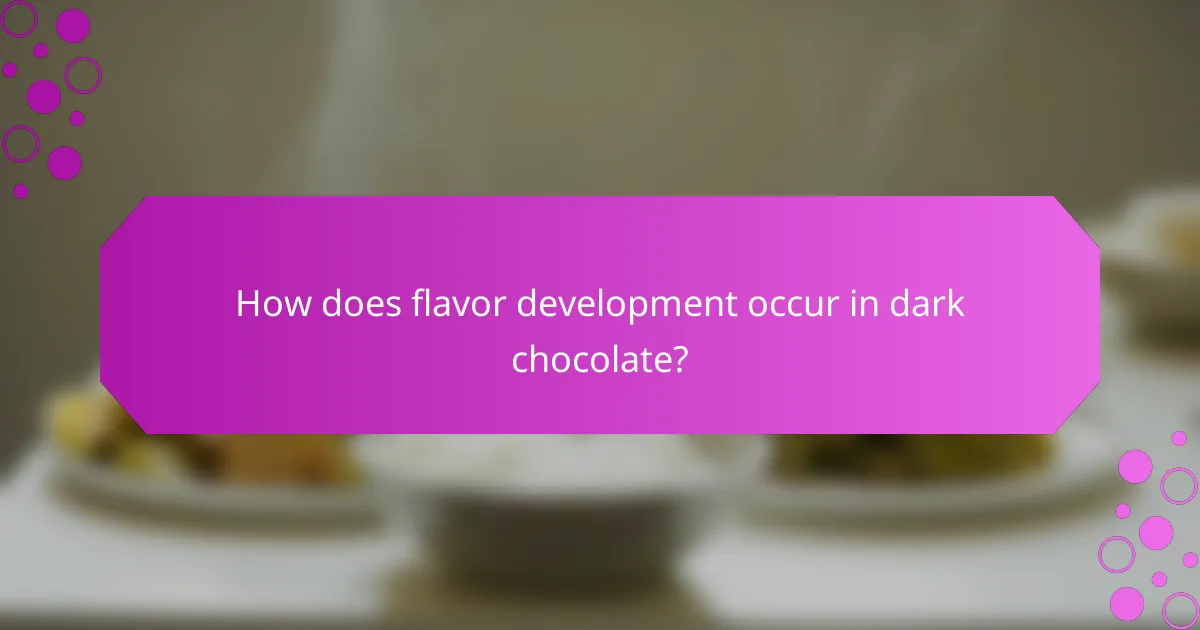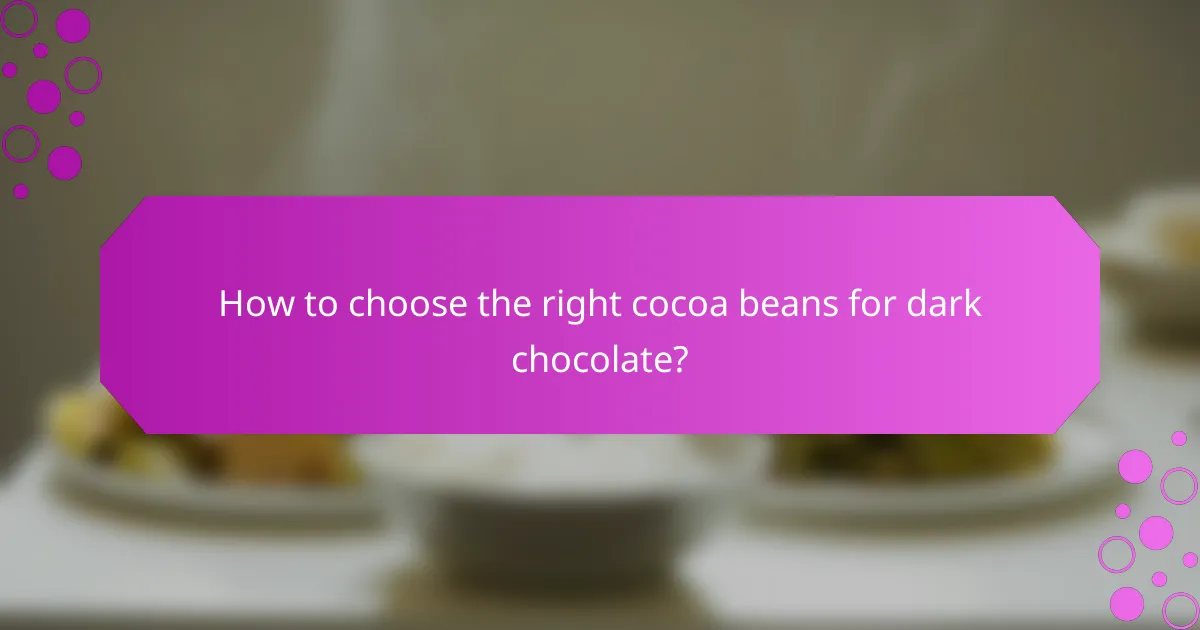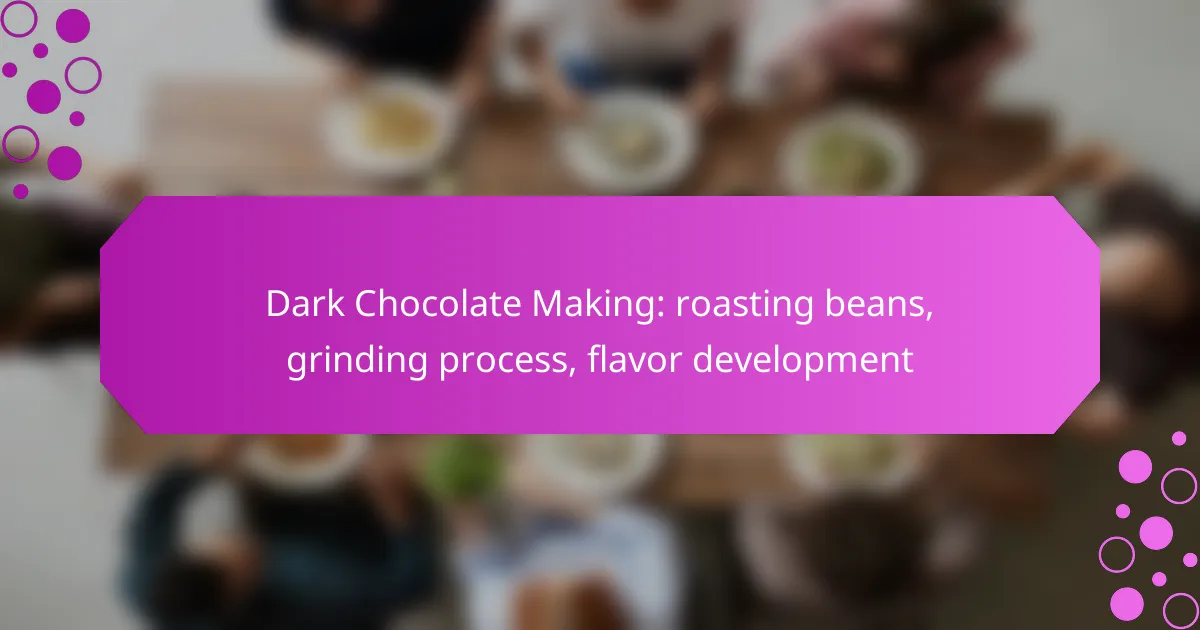Dark chocolate making begins with the roasting of cocoa beans, a vital process that enhances their flavor and aroma. Following roasting, the beans are ground into a smooth chocolate liquor, a critical step that influences the final texture and taste. Flavor development occurs through careful roasting and conching, transforming raw cacao into a rich, complex product with distinct taste profiles.

How to roast cocoa beans for dark chocolate?
Roasting cocoa beans is a crucial step in dark chocolate production, enhancing flavor and aroma. Proper roasting transforms raw beans into a rich, aromatic base for chocolate, requiring attention to temperature and time.
Roasting temperature and time
The ideal roasting temperature for cocoa beans typically ranges from 120°C to 160°C (248°F to 320°F). Roasting times can vary from 15 to 30 minutes, depending on the desired flavor profile and bean type.
Monitor the beans closely to avoid over-roasting, which can lead to bitterness. A good practice is to check for a color change and listen for the first crack, indicating that the beans are nearing readiness.
Choosing the right cocoa beans
Selecting high-quality cocoa beans is essential for producing excellent dark chocolate. Look for beans that are well-fermented and dried, as these factors significantly influence flavor development.
Different varieties, such as Criollo, Forastero, and Trinitario, offer distinct flavor profiles. Experimenting with various beans can help you discover unique taste combinations for your chocolate.
Equipment needed for roasting
To roast cocoa beans effectively, you will need a reliable heat source and a roasting device. Options include a home oven, a stovetop pan, or specialized cocoa bean roasters.
Additionally, a thermometer is crucial for monitoring temperature, while a cooling tray will help quickly cool the beans post-roasting. Ensure you have proper ventilation, as roasting can produce smoke and strong aromas.

What is the grinding process in dark chocolate making?
The grinding process in dark chocolate making transforms roasted cocoa beans into a smooth chocolate liquor. This step is crucial as it affects the texture and flavor profile of the final product, requiring careful attention to the type of grinder used and the techniques employed.
Types of grinders for cocoa
There are several types of grinders suitable for cocoa, each with its own advantages. Stone grinders are traditional and provide a fine texture while preserving flavor, making them popular among artisanal chocolate makers. Conching machines, on the other hand, are designed for larger batches and can achieve a very smooth consistency, often used in commercial production.
Other options include wet grinders and ball mills, which can efficiently process cocoa nibs into liquor. When selecting a grinder, consider the batch size, desired texture, and production scale to ensure the best results.
Grinding techniques for optimal texture
To achieve optimal texture in dark chocolate, it is essential to control the grinding duration and temperature. Grinding should be done gradually, allowing the cocoa nibs to release their natural fats, which helps create a smoother consistency. Aim for a grinding time of several hours for small batches, adjusting based on the grinder type and desired fineness.
Monitoring the temperature is also critical, as excessive heat can negatively impact flavor. A good practice is to keep the grinding temperature below 50°C (122°F). Regularly check the texture during the process and stop once the desired smoothness is achieved, avoiding over-grinding which can lead to a gritty texture.

How does flavor development occur in dark chocolate?
Flavor development in dark chocolate occurs through a series of processes, primarily roasting and conching, which transform the raw cacao beans into a complex, rich product. These stages enhance the natural flavors and aromas, resulting in the distinct taste profiles associated with high-quality dark chocolate.
Impact of roasting on flavor
Roasting cacao beans is crucial for flavor development, as it activates various chemical reactions that enhance the beans’ natural flavors. The temperature and duration of roasting can significantly influence the final taste; typically, temperatures range from 120°C to 150°C for about 20 to 30 minutes.
During roasting, Maillard reactions and caramelization occur, producing a range of flavor compounds. Lighter roasts tend to preserve more fruity and floral notes, while darker roasts develop deeper, more robust flavors such as chocolatey, nutty, or even smoky profiles.
Role of conching in flavor enhancement
Conching is a mechanical process that further refines the chocolate mixture, improving its texture and flavor. This process involves continuously mixing and aerating the chocolate at controlled temperatures, typically for several hours to days, allowing volatile acids to evaporate and undesirable flavors to dissipate.
During conching, the chocolate’s flavor profile can be fine-tuned by adjusting the duration and temperature. Longer conching times generally lead to smoother textures and more balanced flavors, while insufficient conching may result in a gritty texture and less developed taste. Aim for a conching time of at least 12 hours for optimal results.

What are the best practices for dark chocolate production?
Best practices for dark chocolate production involve careful attention to the roasting of beans, the grinding process, and the development of flavors. These steps are crucial for achieving high-quality chocolate that meets consumer expectations.
Quality control measures
Implementing quality control measures is essential throughout the dark chocolate production process. Regular sampling of cocoa beans during roasting helps ensure optimal flavor development and prevents over-roasting, which can lead to bitterness.
Additionally, monitoring the grinding process is vital. The consistency of the chocolate liquor should be checked frequently to ensure it meets the desired texture and viscosity. Using standardized equipment can help maintain these quality benchmarks.
Ingredient sourcing for flavor
Sourcing high-quality ingredients is critical for enhancing the flavor profile of dark chocolate. Look for cocoa beans from reputable suppliers who adhere to sustainable farming practices, as this can significantly impact taste and aroma.
Consider experimenting with different origins of cocoa beans, as beans from regions like Madagascar or Ecuador can impart unique flavor notes. It’s also beneficial to use organic or fair-trade certified ingredients, which can appeal to a growing segment of health-conscious consumers.

What equipment is essential for home chocolate making?
Essential equipment for home chocolate making includes a home roasting machine and chocolate tempering tools. These tools facilitate the roasting of cacao beans and the proper tempering of chocolate, ensuring a smooth texture and rich flavor.
Home roasting machines
A home roasting machine is crucial for transforming raw cacao beans into roasted beans, which enhances their flavor profile. These machines can range from simple popcorn poppers to specialized chocolate roasters, allowing for different roasting techniques and batch sizes.
When selecting a roasting machine, consider factors such as capacity, temperature control, and ease of use. A good machine should allow you to experiment with roast levels, as lighter roasts can yield fruity notes while darker roasts may produce more bitter flavors.
Chocolate tempering tools
Tempering tools are necessary for achieving a glossy finish and a firm snap in chocolate. Common tools include a marble slab for manual tempering, a thermometer for monitoring temperatures, and a microwave or double boiler for melting chocolate.
For home chocolate makers, a simple method is to melt chocolate to around 45-50°C, then cool it to 27-28°C before reheating slightly to 31-32°C. This process stabilizes the cocoa butter crystals, resulting in a smooth and shiny final product.

How to choose the right cocoa beans for dark chocolate?
Choosing the right cocoa beans is crucial for producing high-quality dark chocolate. Look for beans that are fresh, well-fermented, and sourced from reputable growers to ensure optimal flavor and texture.
Varietals of cocoa beans
Cocoa beans come in several varietals, each with unique characteristics. The three main types are Criollo, Forastero, and Trinitario. Criollo beans are rare and prized for their complex flavors, while Forastero beans are more common and robust, often used in mass-produced chocolate. Trinitario is a hybrid that combines the best traits of both.
When selecting beans, consider the varietal’s availability and your desired flavor profile. Criollo may be more expensive and harder to find, but it can elevate the quality of your chocolate significantly.
Flavor profiles of different beans
The flavor profiles of cocoa beans vary widely based on their origin and processing methods. For example, beans from Madagascar often have fruity and floral notes, while those from Ecuador can exhibit nutty and earthy flavors. Understanding these profiles helps in selecting beans that align with your chocolate-making goals.
To enhance flavor development, experiment with roasting times and temperatures. Lightly roasted beans may retain more fruity notes, while darker roasts can bring out deeper, more bitter flavors. Keep in mind that the balance between acidity and bitterness is key to achieving a well-rounded dark chocolate.
